This first table shows the Watts/10 Delta Temp numbers for the Nemesis 280 GTS X-Flow in a quick glance chart format.

Using this data we can effectively show percentage gains/losses relative to a reference point. It’s an interesting way to show gains/losses while changing a variable.
So, let’s focus on 1300 RPM as our reference and see how much gain or loss in performance we get by changing fan speed.
So from the data above we’re getting a good idea of how the Nemesis 280 GTS X-Flow radiator performs relative to itself. But there is a large selection of 280mm radiator models to choose from, so let’s put it’s results into some comparison charts.
Push Only Data vs Competition
In general, thicker radiator perform better than thinner radiators of the same size (fan capacity) but a lot also has to do with how each core has been designed / tuned; number of tubes, thickness of tubes, fin array etc.
If it were thickness alone we should expect the Nemesis 280 GTS X-Flow to always be near the bottom and our testing would be totally unnecessary.
Focusing on the Push Only results for now, let’s see how the Nemesis 280 GTS X-Flow performed compared to the competition.
Let’s start with 750 RPM.
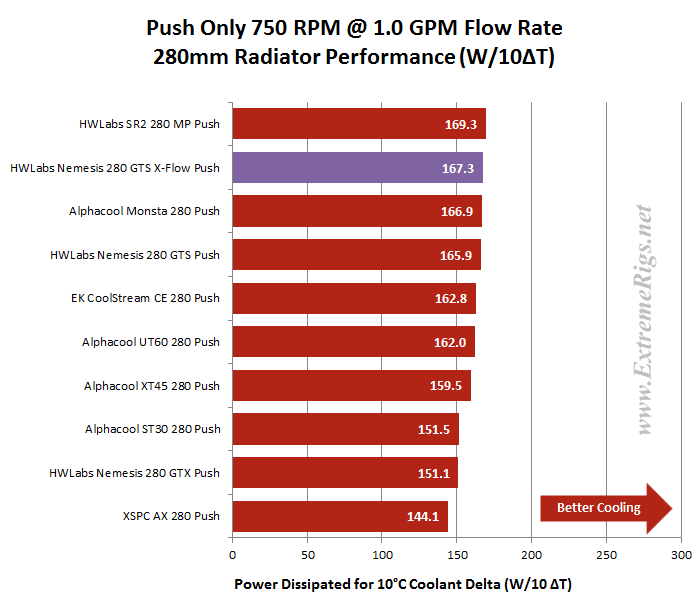
Amazing!! Clearly this is an awesome result for the Nemesis 280 GTS X-Flow. Finishing in second place and just ~1% behind the winner. It was the best performing slim radiator, just ahead of the regular 280 GTS and beating other radiators that are twice as thick (and more).
Now let’s look at 1300 rpm:
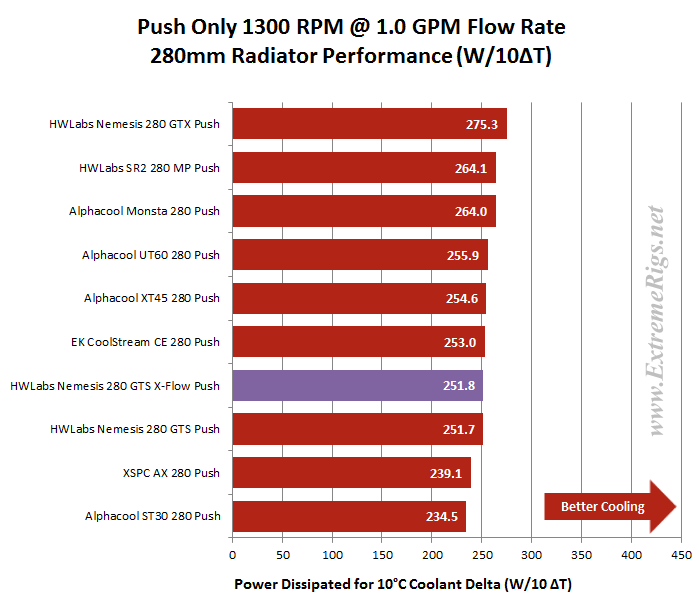 At Push Only 1300 RPM the group settles roughly into order of thickness. The 2 Nemesis GTS models have virtually identical results and are ~7% ahead of the other slim in the group.
At Push Only 1300 RPM the group settles roughly into order of thickness. The 2 Nemesis GTS models have virtually identical results and are ~7% ahead of the other slim in the group.
Now 1850 rpm Push Only:
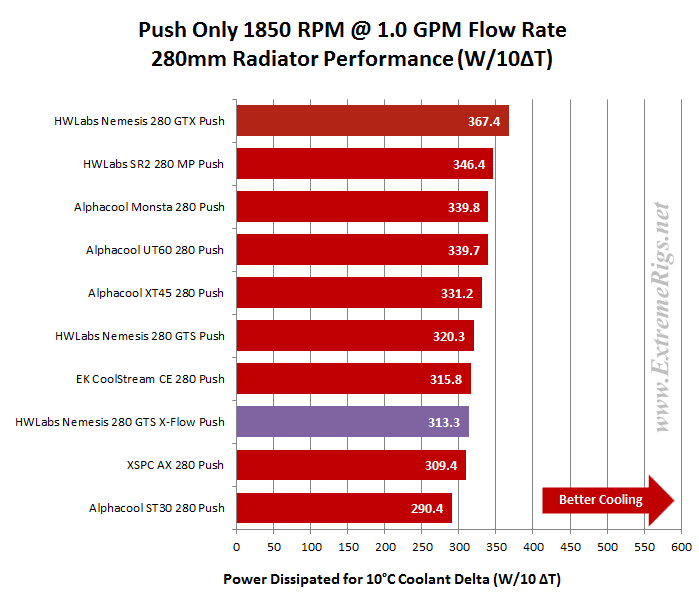 At 1850 rpm the Nemesis 280 GTS X-Flow stays in a similar ranking, 3rd from last and ~15% behind it’s dominant stable mate, the Nemesis GTX which is 25mm (or + 83%) thicker.
At 1850 rpm the Nemesis 280 GTS X-Flow stays in a similar ranking, 3rd from last and ~15% behind it’s dominant stable mate, the Nemesis GTX which is 25mm (or + 83%) thicker.
Push/Pull Data vs. Competition
Firstly the 750 rpm:
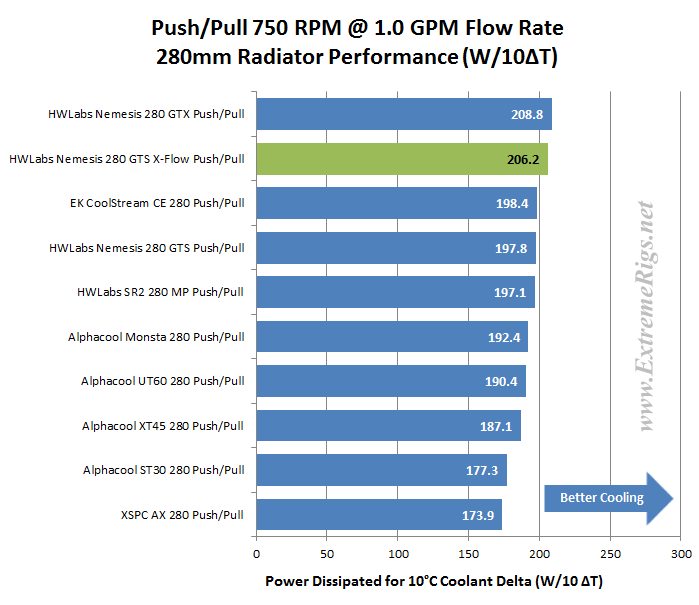 At 750 rpm P/P the Nemesis 280 GTS X-Flow is at the top end of the comparison chart. Finishing in 2nd place and just 1.25% behind the winner, it is obvious this radiator has it’s best comparison results with low speed fans.
At 750 rpm P/P the Nemesis 280 GTS X-Flow is at the top end of the comparison chart. Finishing in 2nd place and just 1.25% behind the winner, it is obvious this radiator has it’s best comparison results with low speed fans.
Let’s move to 1300 rpm:
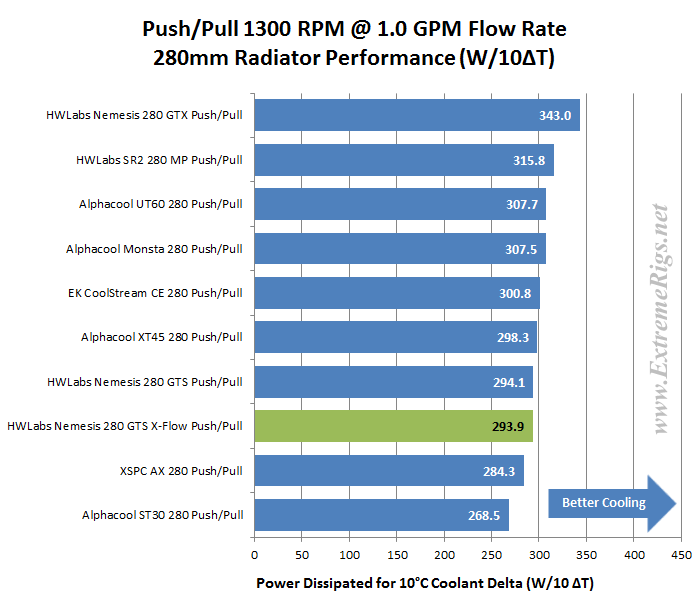 Here we see very similar ranking to which we saw at Push Only 1300. In Push/Pull the Nemesis 280 GTS X-Flow and it’s sibling NON X-Flow variant have performed almost identically and are clear of the other slim radiator by ~9%.
Here we see very similar ranking to which we saw at Push Only 1300. In Push/Pull the Nemesis 280 GTS X-Flow and it’s sibling NON X-Flow variant have performed almost identically and are clear of the other slim radiator by ~9%.
Now 1850 rpm:
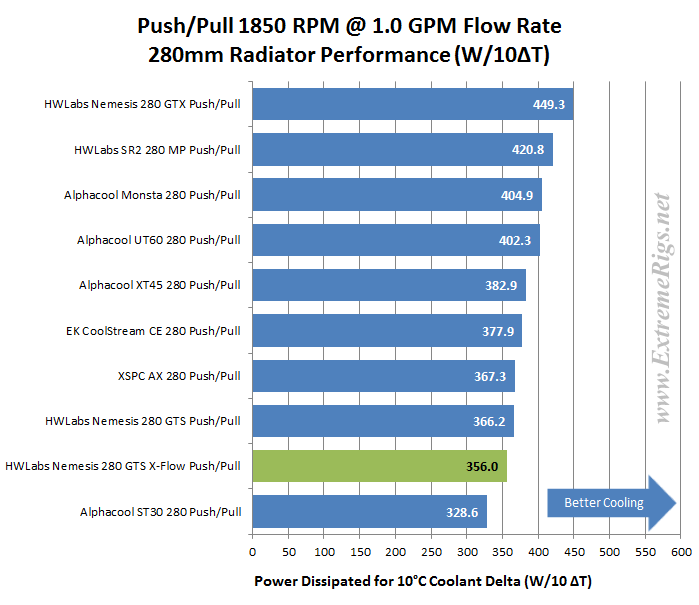 At 1850 rpm Push/Pull the Nemesis 280 GTS X-Flow is the second best performing of the slim radiators in the group. It can’t match the performance of the thicker radiators and is ~3% behind the regular 280 GTS.
At 1850 rpm Push/Pull the Nemesis 280 GTS X-Flow is the second best performing of the slim radiators in the group. It can’t match the performance of the thicker radiators and is ~3% behind the regular 280 GTS.
Let’s now combine the Push Only and Push/Pull results of our 1.0 GPM flow rate tests. Sometimes these combined plots show up points of interest, though they can get a little busy and perhaps confusing if you’re not used to them.
750 rpm first:
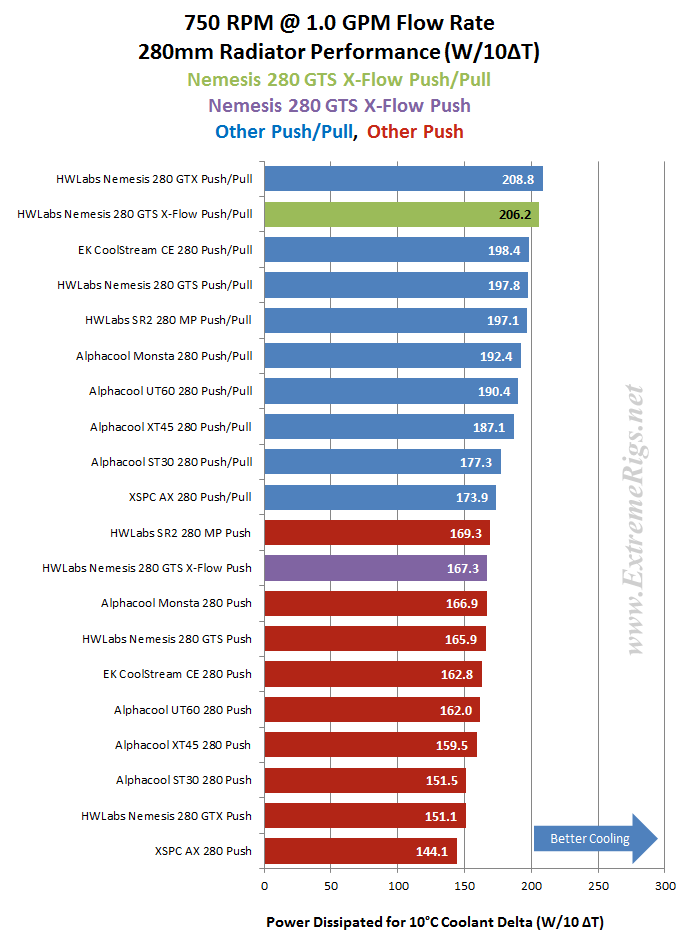 This is a great plot for the Nemesis 280 GTS X-Flow showing it placed 2nd in both Push Only and Push/Pull.
This is a great plot for the Nemesis 280 GTS X-Flow showing it placed 2nd in both Push Only and Push/Pull.
At 1300 rpm everything looks in order given the data we have already reviewed..
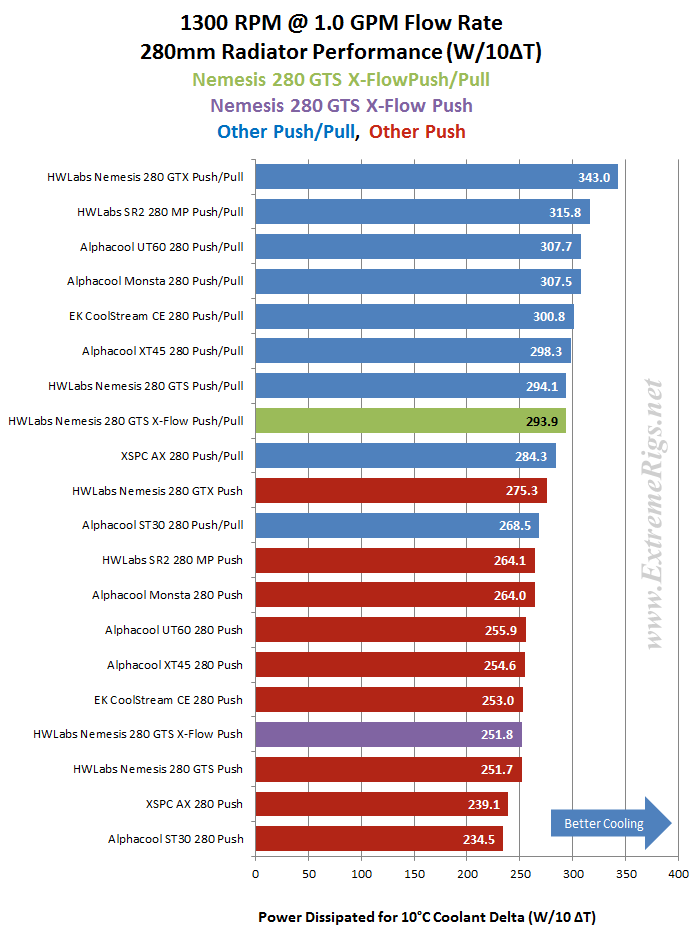
At 1850 the Push Only result of the Nemesis 280 GTS is only 4.5% behind the Push/Pull result of the ST30 which is also a 30mm thick radiator. Interesting!
On the other side of the coin, if you know you are going to use high fan speeds it may be wise to further investigate the Nemesis 280 GTX (our review to be published soon) which has better Push Only performance than the GTS X-Flow has in Push/Pull
Another view of the same data, this time plotted as curves and some extrapolation added.
Be warned these plots can be hard to read given that many results are similar at the same data points.
Again the Push Only data first:
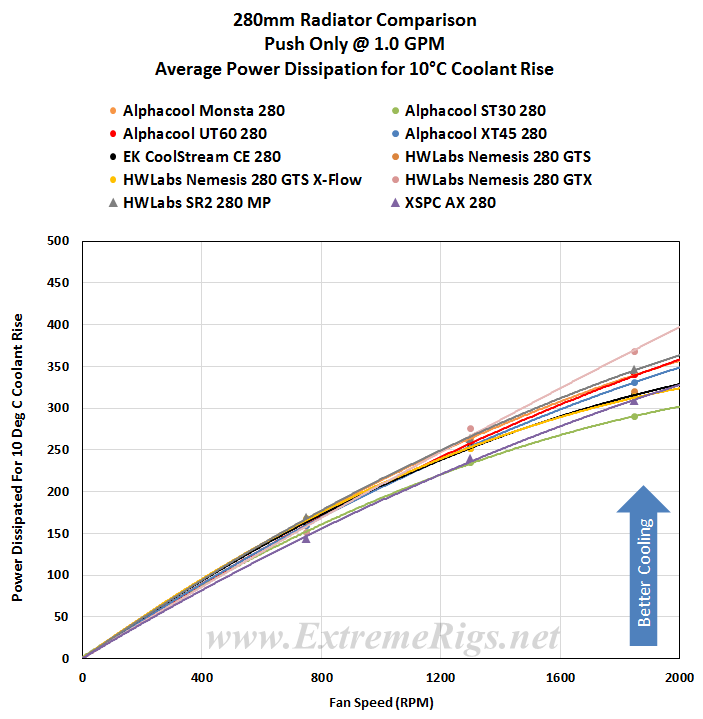 This perhaps best shows just how close the results are, particularly with low speed fans.
This perhaps best shows just how close the results are, particularly with low speed fans.
Because the data curves in the plot above are almost blurred into one another, we have split it into two separate plots; 750 rpm to 1300 rpm and 1300 rpm to 1850rpm and zoomed in on those fan speed zones.
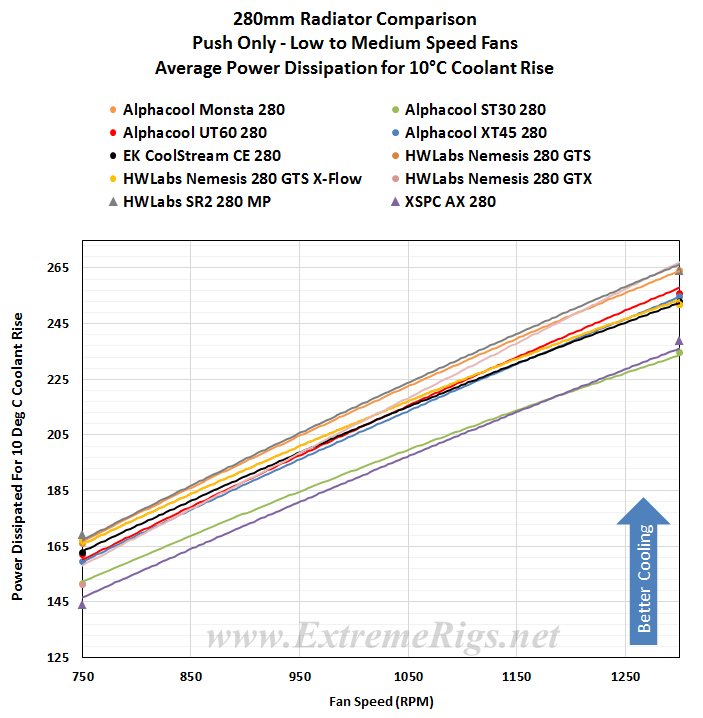 While not totally clear, this plot shows the Nemesis 280 GTS X-Flow is among the best performing radiators in this fan speed zone for Push Only.
While not totally clear, this plot shows the Nemesis 280 GTS X-Flow is among the best performing radiators in this fan speed zone for Push Only.
In the following plot with increased fan speeds we see the thicker cored radiators outperform the thinner GTS X-Flow.
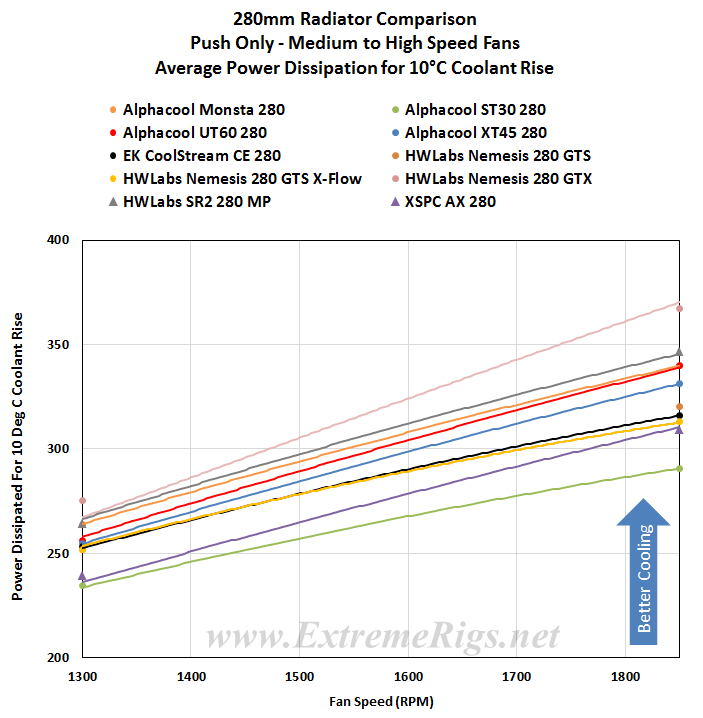
Now the Push/Pull results are plotted, again followed by split and zoomed versions.
Nemesis 280 GTS vs. Nemesis 360 GTS
Before moving on let’s take a quick look at the thermal results for the Nemesis 280 GTS X-Flow and Nemesis 360 GTS X-Flow on the same plot. This is one of those “just for fun” plots because in reality we can’t make a 1 to 1 comparison between the two sizes because of the differing performance of the fans used.
In other 280mm radiator reviews we made the same 280 vs. 360 comparison and saw an interesting and similar pattern start to repeat.
With the GTS- X-Flow that is not the case and we see unusual and unexplained data variations between the two sizes.
The Nemesis 280 GTS X-Flow has ~10% less surface area than the Nemesis 360 GTS X-Flow. Knowing that and the difference in fans used to test the 280 and 360 radiators, interpret the following as you will.
Push Only 750 rpm: 280 GTS X-Flow was ~4% better.
Push/Pull 750 rpm: Equal Performance.
Push Only 1300 rpm: 360 GTS X-Flow was ~5% better.
Push/Pull 1300 rpm: Equal Performance.
Push Only 1850 rpm: 360 GTS X-Flow was ~9% better.
Push/Pull 1850 rpm: 360 GTS X-Flow was ~2% better.
Meaning the 360 GTS had ~3.5% better performance in Push Only
BUT
was only 1% ahead in the Push/Pull comparison.
The overall average of ~2.2% was in favor of the Nemesis 360 GTS, which has a ~10% greater surface area.
The following plot best shows the above data. Again the fan difference makes these comparisons not truly accurate, but it is interesting. Some other radiators followed the 10% area delta with a 10% performance delta. This hasn’t happened with this radiator however.
For every radiator tested we create APF “Average Performance Factor” charts from both the Push Only and Push/Pull results. We also make a combined plot of the average called the “Master Performance Factor”. The radiator with the best cooling ability (W/10ΔT) at each rpm is awarded a score of 100 and every other radiator’s W/10ΔT result is scored as percentage of the top performer.
This way of looking at the comparison takes away any advantages that a radiator may have at higher or lower fan speeds and looks at an overall average. While this appears fair it does tend to favor those radiators that are all-rounders and those radiators which do very well at high RPM. Most users should be more focused on their specific use case.
Here are the Nemesis 280 GTS X-Flow’s percentage scores at each data point:
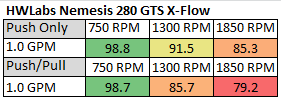 This table shows us that the Nemesis 280 GTS X-Flow is on average ~10% behind the best performing radiator at each data point that was tested, but range from ~1% to over 20%. The results “appear” to get worse with increased fan speeds, but that does not mean that the Nemesis 280 GTS X-Flow’s performance got worse, more so that the best radiator got better as the fan speeds increased.
This table shows us that the Nemesis 280 GTS X-Flow is on average ~10% behind the best performing radiator at each data point that was tested, but range from ~1% to over 20%. The results “appear” to get worse with increased fan speeds, but that does not mean that the Nemesis 280 GTS X-Flow’s performance got worse, more so that the best radiator got better as the fan speeds increased.
As these percentage scores are relative to the best performer at each data point, we again advise readers to cross reference specifications and results for each radiator and keep in mind your intended fan assembly and operating speed.
The percentage numbers in the table above offer another way of looking at the Nemesis 280 GTS X-Flow’s results. But for our scoring system we need a way to reduce the categories while retaining the data. To do this we average the results for each fan assembly type giving us Averaged Performance Factors. We calculate this for Push Only, Push/Pull and finally an average of everything.
Firstly – the Push Only APF:
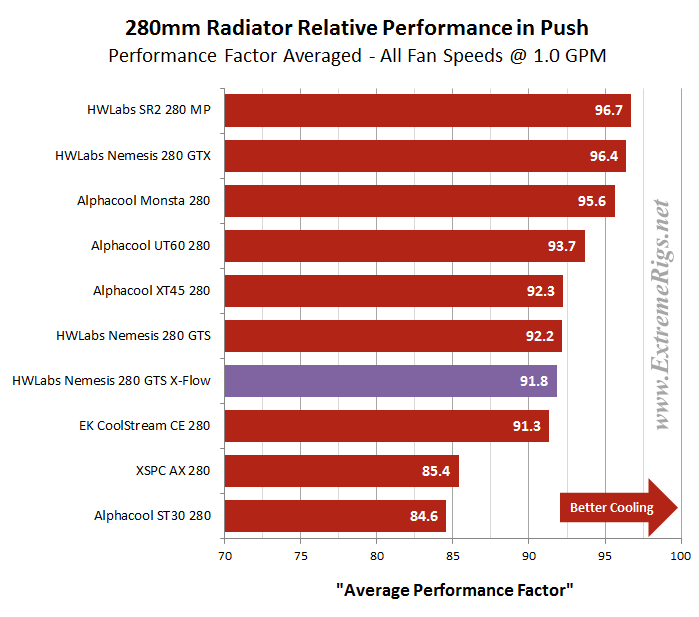 With an 91.8 % Averaged Push Only result the Nemesis 280 GTS X-Flow places equal 5th (after test error margin is factored in) with a radiator which is + 50% thicker than it. This is an excellent data set for the 280 GTS X-Flow.
With an 91.8 % Averaged Push Only result the Nemesis 280 GTS X-Flow places equal 5th (after test error margin is factored in) with a radiator which is + 50% thicker than it. This is an excellent data set for the 280 GTS X-Flow.
Now the Push/Pull APF:
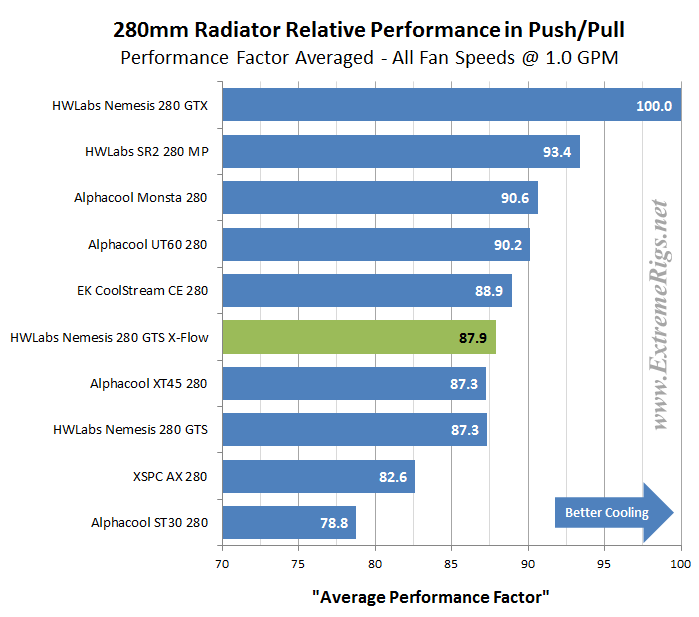 In Push/Pull APF rankings the Nemesis 280 GTS X-Flow places equal 6th with it’s sibling NON X-Flow variant and a 45mm thick radiator. Any weak points were somewhat magnified by the 100% score on the Nemesis 280 GTX. All in all the Nemesis 280 GTS X-Flow performed very well here given it’s thickness and was in equal 1st place for the slim radiators of the group.
In Push/Pull APF rankings the Nemesis 280 GTS X-Flow places equal 6th with it’s sibling NON X-Flow variant and a 45mm thick radiator. Any weak points were somewhat magnified by the 100% score on the Nemesis 280 GTX. All in all the Nemesis 280 GTS X-Flow performed very well here given it’s thickness and was in equal 1st place for the slim radiators of the group.
Finally we created the Master Performance Factor which is calculated from the averaged results of all the Push Only and Push/Pull thermal tests, at all fan speeds.
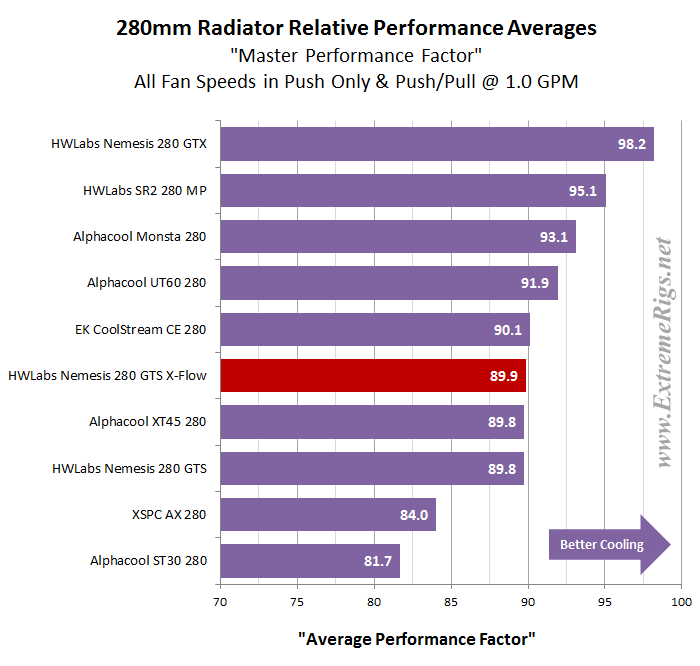 The Nemesis 280 GTS X-Flow placed equal 6th overall, ~ 8.5% behind the winning radiator. Of more relevance is that it came in as the equal top performing slim radiator.
The Nemesis 280 GTS X-Flow placed equal 6th overall, ~ 8.5% behind the winning radiator. Of more relevance is that it came in as the equal top performing slim radiator.
Space Efficiency
The Nemesis 280 GTS X-Flow’s space efficiency vs. performance ranking is likely to be very good as thinner radiators almost always produce better results here than their thicker counterparts. We have used the Average Performance Factor results from the charts above to compile two plots which shows us how it compares to the other rads in terms of performance Vs. space taken.
First up is Radiator Thickness Vs. APF
Here the combined APF scores were divided by the radiator thickness only, with the highest (most space efficient) issued a score of 100. Each of the other radiators results was converted to a percentage of the most space efficient radiator’s score.
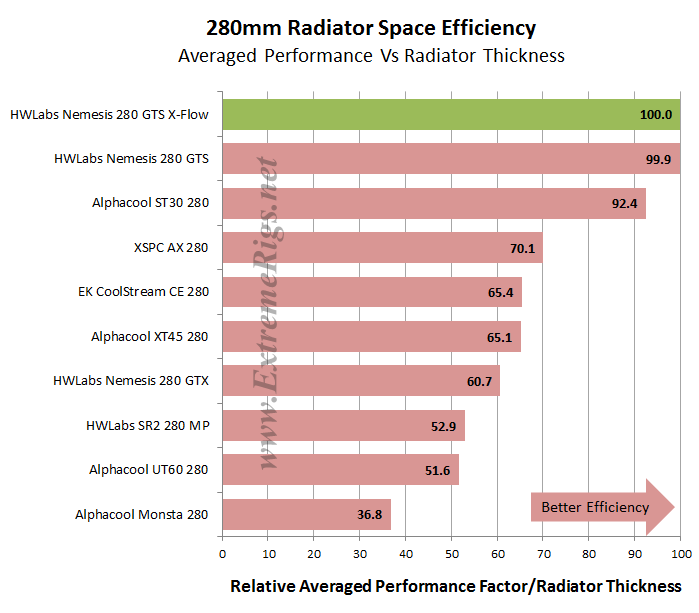 Lets call this an equal 1st place. The order has ended almost in order of thinnest to thickest and as anticipated the Nemesis 280 GTS X-Flow ranked highly in this comparison.
Lets call this an equal 1st place. The order has ended almost in order of thinnest to thickest and as anticipated the Nemesis 280 GTS X-Flow ranked highly in this comparison.
Next we took the APF results for Push/Pull and divided it by the total thickness including the fans and applied the same scoring system. For the Push Only we used the Push Only Vs Push/Pull comparative results and applied the same scoring system when compared against the Push/Pull.
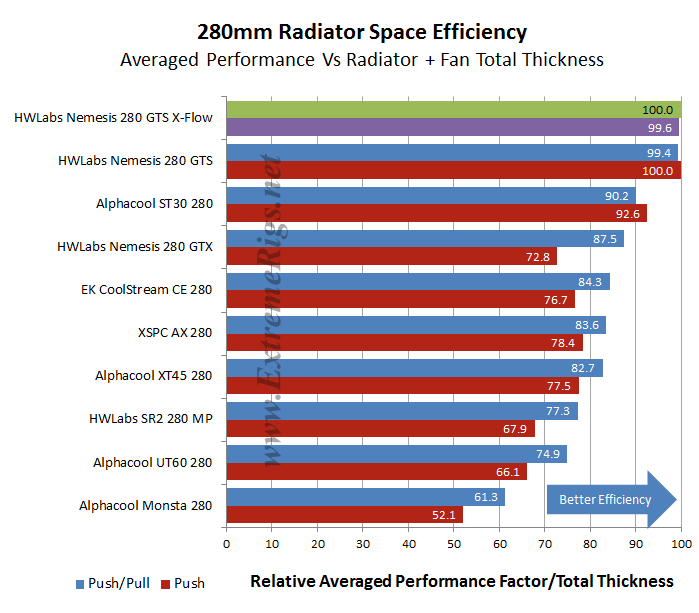 This plot is likely the most useful of the 2 plots for readers looking at space efficiency. With fan thickness factored in the Nemesis 280 GTS X-Flow finishes in equal 1st place for both Push Only and Push/Pull.
This plot is likely the most useful of the 2 plots for readers looking at space efficiency. With fan thickness factored in the Nemesis 280 GTS X-Flow finishes in equal 1st place for both Push Only and Push/Pull.
Value Factor
While our APF’s are still fresh in mind, let’s now look at some results vs Price to show which of the 280mm radiators might offer the best bang for your buck. Each radiator’s combined APF scores were divided by the radiator cost and again we applied our scoring system of percentage Vs. the best performer of the category.
The Nemesis 280 GTS X-Flow Value Factor turns out to be the 2nd best of the group, which tells us that it offers excellent value for the performance potential it offers. In reality the difference is not great, but when visualizing with percentages as we have done, the gap appears large. This is quite evident here because we know the 2 GTS models had very similar performance at every data point and the X-Flow is just $3 more expensive, yet we see nearly a 5% variance between Value Factor scores.
Generally speaking, value and space efficiency metrics usually correlate – thicker radiators do contain more material after-all and so are usually also more expensive.
Next Up – Summary!







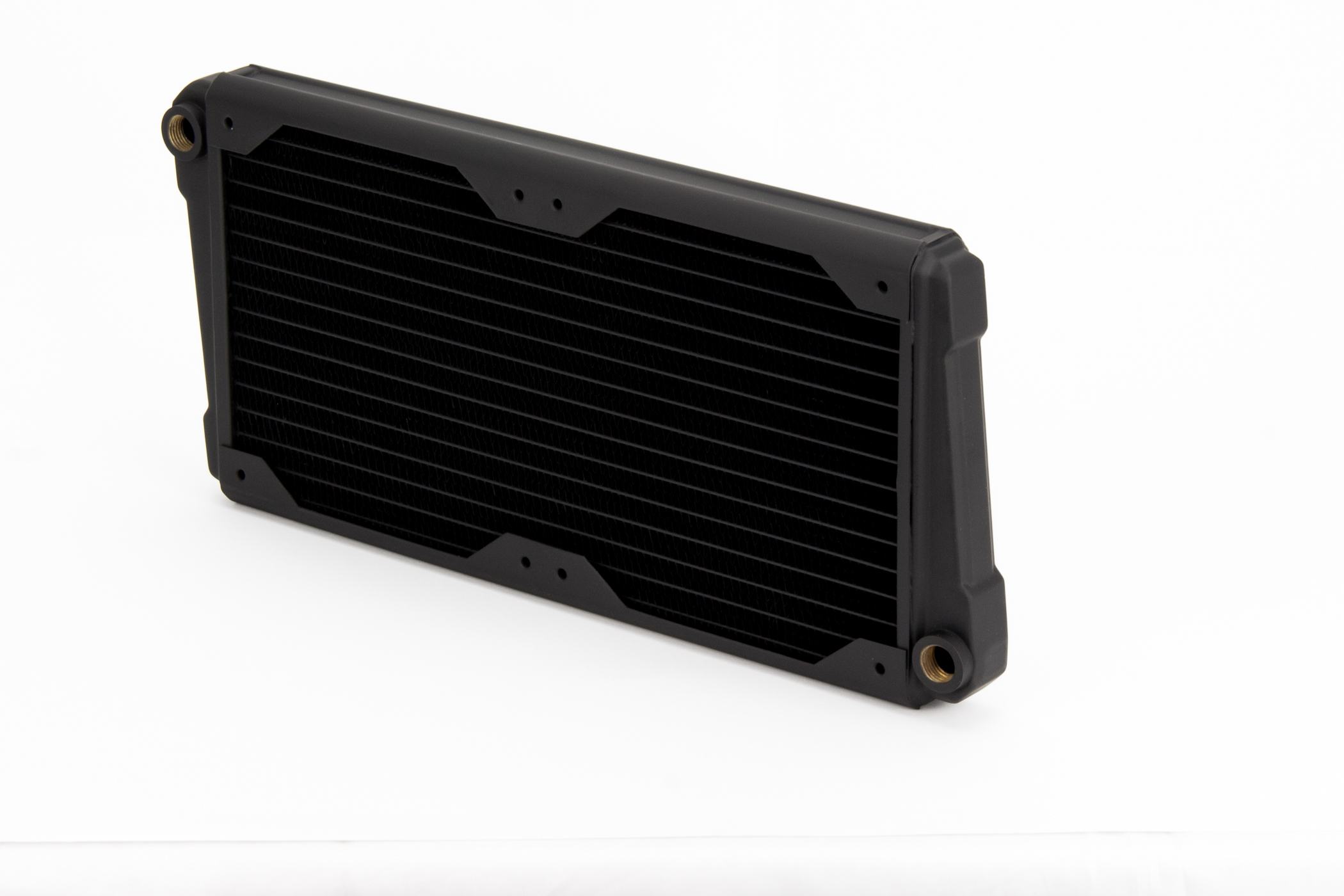

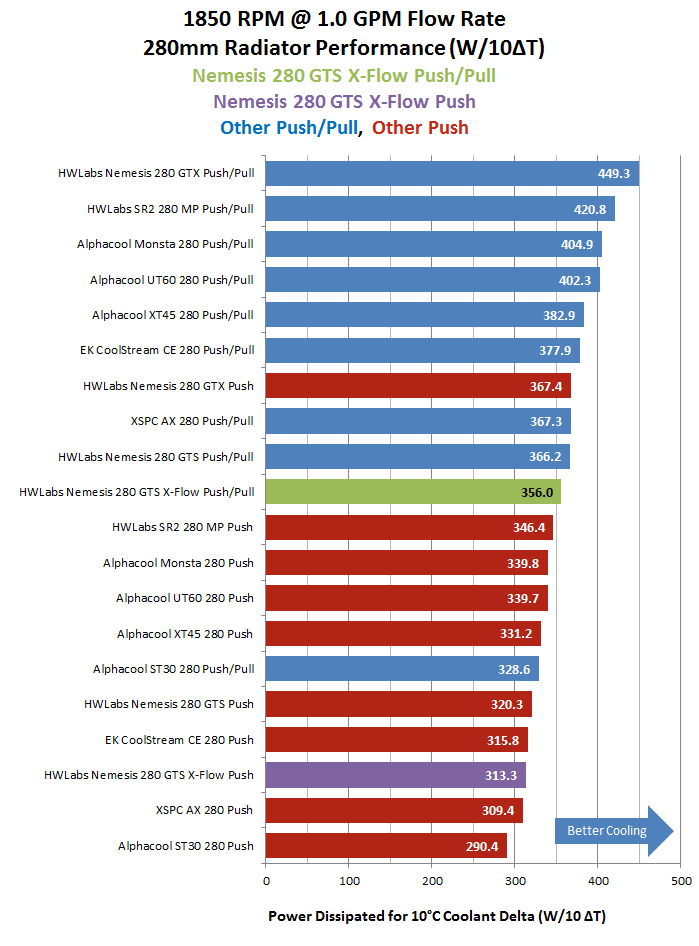
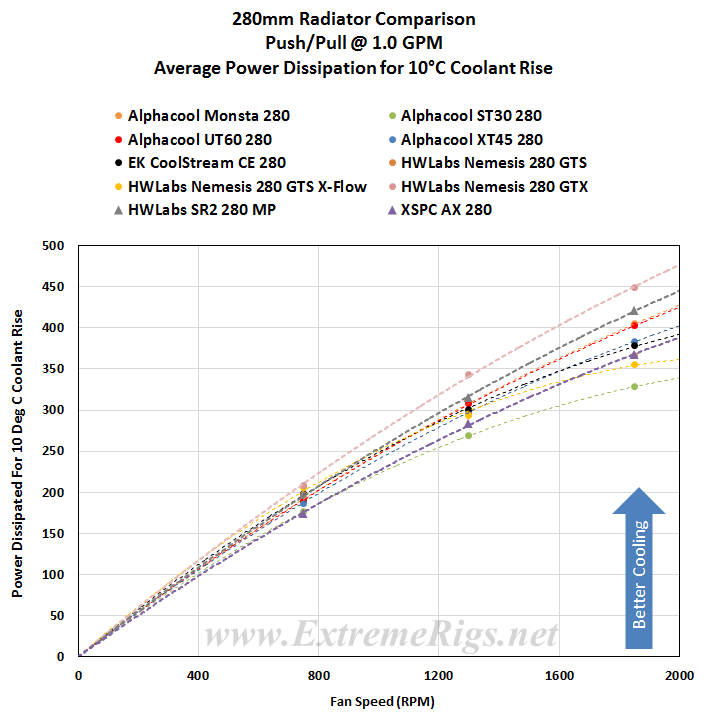
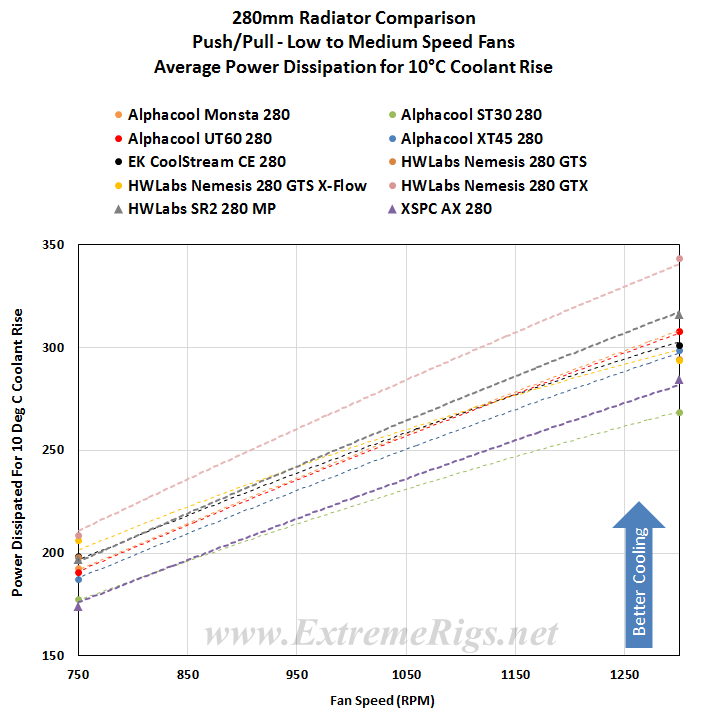
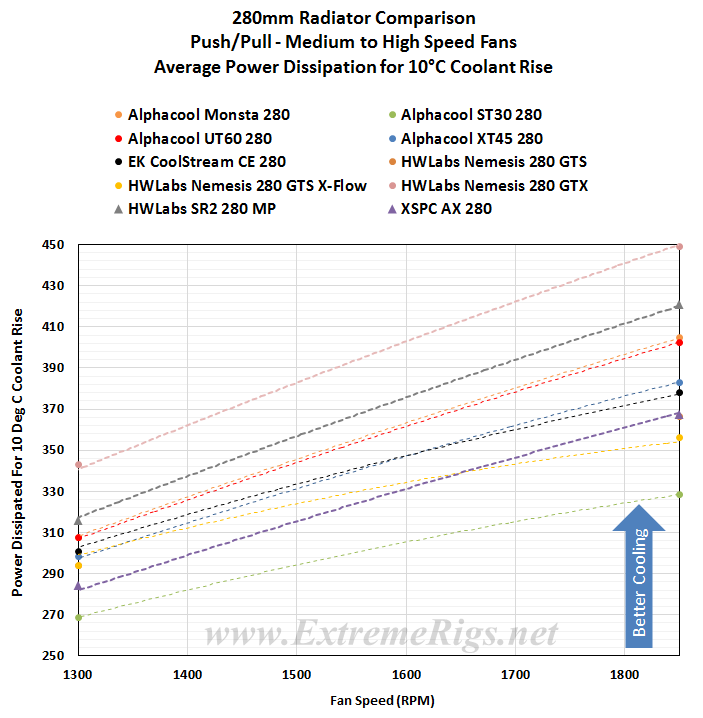
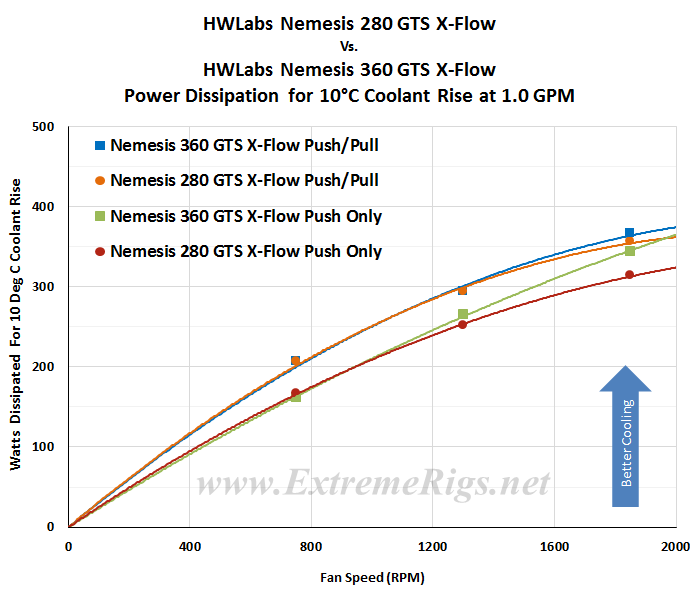
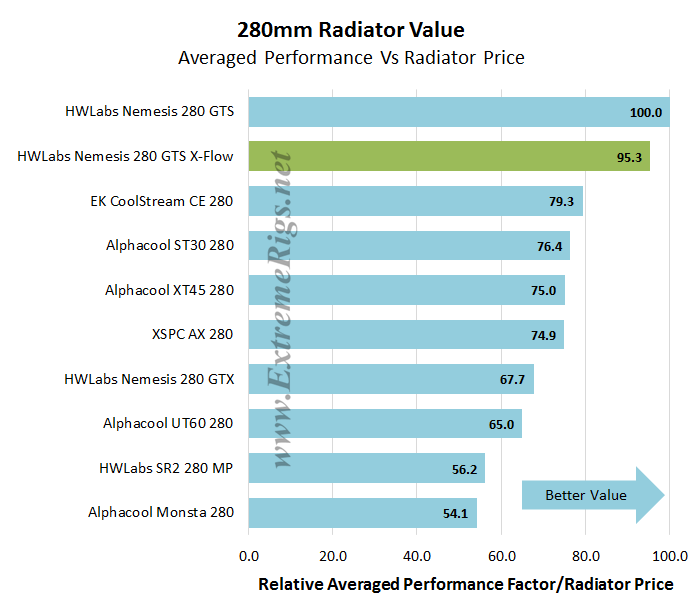



Its amazing how well this rad preforms considering how thin it is. I am very curious to see how it would stack up against a 280 30mm thick version of the Alphacool xflow (suppose to release around the June-August time-frame from what I was told by them)
I have a caselabs mercury s5 so i dont think the length would be a problem, my question is should i go with 2 of these or 2 45mm ek 280’s? cooling a cpu 5820k and a 1070 ftw.
HWLabs rads are sometimes a little wider than most and sometimes don’t fit in CaseLabs cases when you need to mount two next to them for example in the roof of a Mercury case. Measure up first and if in doubt maybe go with the EK ones 🙂
Comments are closed.